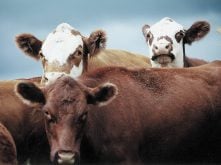This cattle market information is selected from the weekly report from Canfax, a division of the Canadian Cattlemen’s Association. More market information, analysis and statistics are available by becoming a Canfax subscriber by calling 403-275-5110 or at www.canfax.ca.
Fed cattle up slightly
Cull cow prices have nearly doubled since last year and are currently around $150 per hundredweight, partly driven by strong demand for ground beef.
Cow prices tend to drop off when larger numbers of culls come to market after calving, but with this class being in short supply, prices are expected to remain strong. Canadian cows traded at a $15 per cwt. premium to U.S. utility cows.
Read Also

Pakistan reopens its doors to Canadian canola
Pakistan reopens its doors to Canadian canola after a three-year hiatus.
Western markets reported that D1, 2 cows averaged $148.17 last week, while eastern prices were $131.16. On the rail, cows ranged from $282-287 per cwt.
Feeder prices vary
Feeder cows averaged around $160 per cwt. with the top end trading at $180 per cwt. Butcher bulls averaged $170.68 per cwt.
The Alberta fed cattle market remained firm to modestly higher compared to U.S. prices.
Live Alberta fed steers averaged $202 per cwt. and $333-338.50 on the rail. No live heifer prices were available, but the rail trade was the same as the steers.
Ontario fed steers traded from $189-$208.90, and $330-335 on the rail. Live heifers came in at $183.52-$200.56. Those traded on the rail were $329-334 per cwt.
The fed cattle weekly cash to futures basis strengthened to +9.61, a record high, and the Alberta-Nebraska cash basis followed with a $7 Alberta premium.
Prices in Canada are not expected to drop as much as they have in the United States, although next week’s market could trend sideways.
Early week pressure in the futures market along with a stronger Canadian dollar affected feeder markets, resulting in variable prices across the country.
Feeder cattle volumes are down this week with some rumours suggesting producers may be keeping more heifers at home to add to the breeding herd.
Close to 25,000 feeders were sold in Alberta. Steers in the 600-700 pound category averaged $305.15 per cwt. while heifers traded at $300.50 per cwt. British Columbia steers from that weight averaged $301.33, while heifers averaged $268.17.
Saskatchewan cattle averaged the same as Alberta, while Manitoba traded steers at 302.13. Ontario steers showed the largest price dip at $291.18 per cwt., down $7 per cwt. from last week.
Heavier weight cattle in the 800-900 pound ranged across the country from $241-245 per cwt.
Based off the Canfax enhanced price reporting for participating feedlots, October basis contracts do not appear to be strong and margins are projected to be thin, particularly on heavier feeders.
Beef production dips
Domestic beef production dropped off by about four percent compared to last year. Total beef production is estimated at 598 million lb. Pork production has increased by about five percent with 1.3 billion lb., similar to last year’s figures.
Carcass grades show 68 percent are grading AAA with most in the Yield 2 and Yield 3 category. About 28 percent were AA and 1.2 percent graded A. About two percent made Canada Prime.
Canadian cut-out values for the week ending April 11 saw AAA achieve a new price high of $320.18 per cwt., up $4.30 from April 5. However, AA was down by $2.23, trading at $312.31 per cwt.
Boneless beef prices (cow trim) are strong. The domestic product was $3.40 per lb. Australia-New Zealand trim was $2.98 per lb. while South American product was $2.97 per lb.
Cattle supply limited
The U.S. Department of Agriculture’s cattle-on- feed report showed inventories were slightly higher than expected, but placements are still declining month by month because of limited supply.
Marketings in March were at their lowest levels since 1996. So far this year, 8.46 million are on feed, down six percent from last year when nearly nine million were in feedlots.
U.S. fed cattle slaughter is down from year ago levels at a time when beef demand is typically strong.














